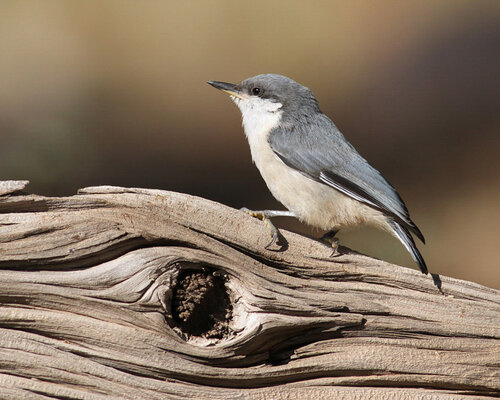Bird of the Month: Pygmy Nuthatch
By Andy McCormick
PC: Clyde Dexter/Audubon Photography Awards (Pygmy Nuthatch)
Scientific Name: Sitta pygmaea
Length 4.25 in
Wingspan 7.75 in
Weight 0.37 oz
AOU Band code PYNU
If you are in this small bird’s primary habitat, which is long-needled pine forests such as Ponderosa Pine, you should be able to find it fairly easily because of its hyperactive behavior and incessant and distinctive three note call. The rapid kit-kit-kit or bip-bip-bip is constantly repeated.
Acrobatic Foragers
Like other nuthatches, this one is fun to watch. Their search for invertebrates and seeds in trees will lead them to highly acrobatic maneuvers such as walking across and along tree trunks and branches including foraging head first down the trunk. Although they also forage in a manner similar to woodpeckers, they do not use their tail for support (Alderfer). Pygmy Nuthatches in particular will also forage at the tips of branches in clusters of pine needles, where they will be seen hammering at a seed to get it open.
A Homebody Kind of Bird
The Pygmy Nuthatch is a homebody in more ways than one. First, it is true to its habitat and does not migrate. It is also highly social and lives in family groups. Adults and young stay together for several generations. Third, during the night Pygmy Nuthatches huddle together for warmth and protection. These clusters of birds can reach large numbers at times with reports of up to 100 in one cavity. Fourth, breeding pairs may get assistance from up to three single relatives who help feed nestlings. They will forage in groups using their call and contact notes for communication with others of their species. In winter Pygmy Nuthatches will be joined by other flocking birds such as kinglets and chickadees. Its cooperative behavior is rare among passerines and more needs to be learned about how that helps in reproduction.
The Pygmy Nuthatch is in the genus Sitta, from the Greek sitte, a nuthatch, originally used by Aristotle for a bird that pecked on a tree. Its genus mates include the Red-breasted, White-breasted, and Brown-headed Nuthatches, the other North American nuthatches, and roughly 21 other species world-wide. Its species name pygmaea, from the Latin Pygmae and Greek Pugmaioi, a mythological race of dwarfs on the upper Nile, references its small size. Nuthatches are known for wedging a nut in tree bark and pecking at it until it breaks open (Holloway). This practice is called hacking and may have led to the name nuthatch (Alderfer).
Cavity Nesters That Love Snags
These nuthatches depend on dead, unmarketable trees for suitable habitat. They nest in tree cavities building a nest made of bark fibers, plant down and feathers. Usually 6-8 reddish-spotted white eggs are deposited. The female incubates the eggs for about two weeks and is fed on the nest by the male and additional helper-birds, usually their older young. Pairs that have helpers fledge more birds than those without helpers (Kaufman). The young leave the nest in about three more weeks and will stay close to the parents. Pygmy Nuthatches are highly successful breeders with 80% of their nests in some areas fledging more than one young. However, their lifespan is only 1.7 years on average. They are particular about their habitat. So, cutting snags leads to production of many fewer nuthatches (Kingery and Ghalambor).
The Pygmy Nuthatch is an indicator species for healthy Ponderosa Pine forests, and they are permanent residents of these forests in Eastern Washington. Their habitat is threatened by logging, fire suppression, which eventually leads to crown fires, and grazing.


